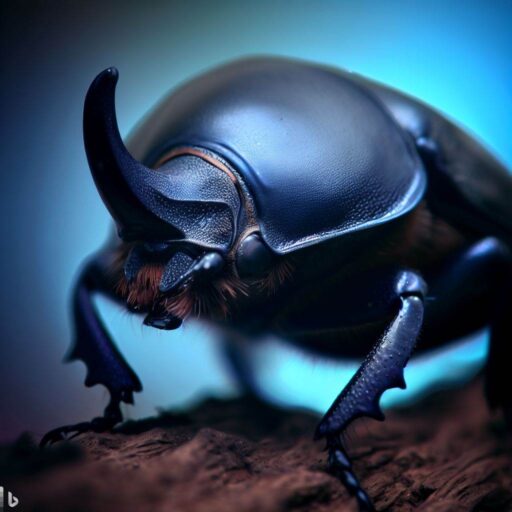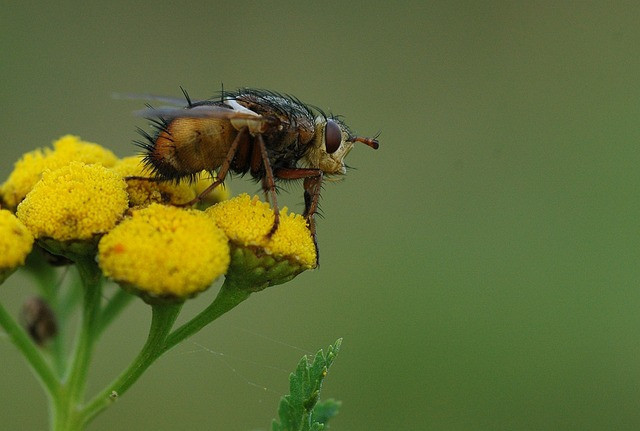.jpg)
What Eats Cucumber Beetles
- Using natural predators such as lady beetles can help control cucumber beetle populations.
- Trap crops can be effective in diverting cucumber beetles away from valuable plants.
- Implementing cultural control methods, like rotating crops and proper sanitation, can help prevent cucumber beetle infestations.
Cucumber beetles are a common pest that can cause destruction to cucumber plants.
Gardeners and farmers must recognize what eats these beetles to regulate their population.
One predator of cucumber beetles is the spined soldier bug (Podisus maculiventris).
It eats a variety of pests, including cucumber beetles.
The tachinid fly (Celatoria diabroticae) is also a predator.
It lays eggs on the beetles.
When the eggs hatch, the larvae eat the beetles – a form of natural control.
The presence of these predators shows the need to maintain biodiversity and promote a healthy ecosystem.
Gardeners and farmers can help control cucumber beetle populations by creating habitats that support predators, such as spined soldier bugs and tachinid flies.
This can be done by intercropping, planting diverse flowers, and limiting the use of pesticides that can harm beneficial insects.
In addition to natural predators, cultural and mechanical methods can also be used to manage cucumber beetle populations.
Crop rotation is effective in disrupting the beetles’ life cycle and reducing their numbers.
Removing crop debris and weeds can get rid of breeding sites.
Applying physical barriers, like row covers, can stop adult beetles from accessing the plants and laying eggs.
Pro Tip: Monitor cucumber beetle populations regularly and adjust management strategies.
Integrated pest management that combines multiple control tactics can help achieve long-term control while reducing chemical insecticides.
Natural Predators of Cucumber Beetles

Cucumber beetles are pests that damage cucumbers and other plants.
Natural predators help keep their population in check and maintain a balanced ecosystem.
These predators include ladybugs, ground beetles, spiders, birds, and tachinid flies.

Environmental factors, such as extreme temperatures and drought, can also affect the survival and reproduction of cucumber beetles.
Yet, natural predators remain important for the balance between the beetles and their habitat.
To protect plants from cucumber beetles, there are a few things you can do:
- Attract beneficial insects through native flowers.
- Rotate the location of cucumber plants each year.
- Use organic and natural pest control methods, like insecticidal soap or neem oil.
By understanding natural predators and following these steps, you can effectively control cucumber beetle population and protect your cucumber plants.
Trap Crops for Controlling Cucumber Beetles

Trap crops are a useful tool for controlling cucumber beetles.
Plant them strategically near your main crops to lure the beetles away.
Use them as a sacrificial plant, and monitor them regularly.
Trap crops can also provide info on beetle presence and activity.
Use them with other pest control strategies for best results.
Uniquely, certain varieties or cultivars have been shown to be highly attractive to cucumber beetles.
Plant them to draw the pests away from main crops.
Trap crops can also attract beneficial insects that prey on cucumber beetles.
This technique has been used for years.
Farmers study cucumber beetles to identify trap crops that divert them away from main crops.
This reduces the need for insecticides and minimizes crop damage.
Cultural Control Methods
Cultural control methods are a must for managing cucumber beetles and safeguarding crops.
Practices reducing their population and create an environment unfriendly to them are key.
Crop rotation is a great way to disrupt their life cycle. By planting different crops in an orderly sequence, beetles can’t find their preferred host plants, resulting in fewer numbers.
Trap crops such as radishes or marigolds can draw them away from the main crops and minimize damage.
Row covers made of fabric or mesh can block them from the plants, reducing infestations.
Keeping fields clean and weed-free also helps reduce populations. Removing plant debris and weeds can reduce resources for them.
Plus, proper irrigation and fertilization promote plant health and resilience.
Regular monitoring for beetles is vital for early detection and prompt intervention to prevent damage.
Using Row Covers to Prevent Infestations
Row covers are a great choice for blocking cucumber beetles. These lightweight fabric covers form a physical barrier, keeping the beetles away from the plants.
They can stop feeding damage and egg-laying, hence saving the plants from harm.
For using row covers, follow these six steps:
- Pick the right type: Select a lightweight fabric that lets air, water, and light pass through but keeps bugs out. This helps the plants to grow.
- Prepare the planting area: Clear the area of weeds and debris to make sure the row cover will be firmly placed.
- Install the cover: Unroll it over the planting area and anchor it to the ground using stakes or rocks. This keeps pests away from the edges.
- Create ventilation: If the row cover doesn’t have built-in ventilation, make small openings to allow air circulation and prevent overheating.
- Monitor the plants: Check them regularly for any pest activity or damage. If needed, take out the cover to examine the plants more closely.
- Remove the cover when necessary: Once the threat of cucumber beetles is gone, or when the plants need to be pollinated, carefully take out the cover to avoid harming the plants.
Apart from protecting from cucumber beetles, row covers also offer other benefits.
They can create a warmer microclimate, thus extending the growing season.
Besides, they can protect the plants from frost and strong winds.
Therefore, using row covers can help to create a healthy environment for plant growth and reduce the risk of infestations.
Monitoring and Manual Removal of Beetles
Consistent monitoring of cucumber crops is key to identify and remove cucumber beetles.
Inspect plants and manually pick off any pests found. Barriers like row covers and nets can help keep beetles out.
Rotating crops can also disrupt their life cycle.
Taking these measures can protect crops and ensure successful harvests.
Using Yellow Sticky Traps
Yellow sticky traps are a great way to keep cucumber beetles in check.
These traps are bright yellow and covered with a sticky material that the beetles can’t escape from.
It’s a professional, reliable solution that doesn’t involve any chemical pesticides, and is easy to use and maintain.
Using yellow sticky traps is an economical and eco-friendly choice.
Place them near cucumber plants or along crop borders where beetle activity is high.
Monitor and replace them regularly for best results.
These traps have been proven to be successful in reducing cucumber beetle numbers.
Farmers and gardeners can use them to protect their crops without resorting to chemical pesticides.
They are an important part of integrated pest management strategies.
Organic Pesticides for Controlling Cucumber Beetles
Cucumber beetles are a common pest that can cause destruction to cucumber plants.
Gardeners and farmers must recognize what eats these beetles to regulate their population.
One predator of cucumber beetles is the spined soldier bug (Podisus maculiventris).
It eats a variety of pests, including cucumber beetles.
The tachinid fly (Celatoria diabroticae) is also a predator.
It lays eggs on the beetles.
When the eggs hatch, the larvae eat the beetles – a form of natural control.
The presence of these predators shows the need to maintain biodiversity and promote a healthy ecosystem.
Gardeners and farmers can help control cucumber beetle populations by creating habitats that support predators, such as spined soldier bugs and tachinid flies.
This can be done by intercropping, planting diverse flowers, and limiting the use of pesticides that can harm beneficial insects.
In addition to natural predators, cultural and mechanical methods can also be used to manage cucumber beetle populations.
Crop rotation is effective in disrupting the beetles’ life cycle and reducing their numbers.
Removing crop debris and weeds can get rid of breeding sites.
Applying physical barriers, like row covers, can stop adult beetles from accessing the plants and laying eggs.
Pro Tip: Monitor cucumber beetle populations regularly and adjust management strategies.
Integrated pest management that combines multiple control tactics can help achieve long-term control while reducing chemical insecticides.
Additional Tips for Cucumber Beetle Control
Cucumber beetles can be pesky in the garden, but there are extra tips to help control them.
- Plant radishes or squash nearby to draw them away from cucumbers.
- Use row covers to physically protect cucumbers.
- Spray neem oil or pyrethrin-based insecticides to target and control beetles.
- Invite beneficial insects, such as ladybugs and lacewings, which eat cucumber beetles.
These extra tips for cucumber beetle control can help fight infestations.
But, there is more. Clean up any debris and rotate cucumber plants to different areas each year.
This combined with the other tips can increase cucumber beetle control.
Conclusion
Cucumber beetles are pesky pests that can cause serious harm to cucumber plants. Fortunately, there are natural predators like ladybugs, lacewings, and predatory stinkbugs that feed on them.
These helpful bugs are drawn to the plants by the beetles’ presence, helping reduce their numbers.
Parasitic wasps, like the tachinid fly, also aid in controlling cucumber beetles. The fly’s eggs are laid on the pests, and the larvae that hatch eat the beetles, eventually killing them.
This biological control method can be effective when managing beetle populations.
It’s important to note that natural predators and biological controls won’t totally eliminate the pests.
Therefore, it’s advised to use other integrated pest management strategies with these methods.
Examples include crop rotation, planting resistant varieties, and carefully using insecticides.
By combining different strategies, farmers and gardeners can manage cucumber beetle populations and guard their cucumber plants from harm.
Natural predators and biological control reduce the need for chemical insecticides, making for a more sustainable and eco-friendly approach to pest management.
Some Facts About What Eats Cucumber Beetles:
- ✅ Ladybugs are natural predators of cucumber beetles and can help control their populations.
- ✅ Braconid wasps are also natural predators of cucumber beetles and can be effective in reducing their numbers.
- ✅ Green lacewings feed on cucumber beetles and can be a beneficial insect to have in your garden.
- ✅ Chickens can scratch the soil and eat wireworms, which are pests that can be found inside the roots and stems of plants.
- ✅ The use of beneficial nematodes can help control wireworms, which are pests that can damage cucurbit crops.
FAQ
What eats cucumber beetles?
Cucumber beetles have several natural enemies that can help control their population. Ladybugs, braconid wasps, and green lacewings are known to prey on cucumber beetles.
Can I use hot peppers, garlic, and dish soap to deter cucumber beetles?
While a mixture of hot peppers, garlic, and dish soap may help deter cucumber beetles, it is unclear if it can harm crops.
It is always best to test a small area before applying it to your entire garden.
How can I control cucumber beetles in my squash plants?
Cucumber beetles can be easily caught in the male flowers of squash plants. Use eye tweezers to catch them in the flowers and your fingers to catch them on the leaves.
Monitoring your plants regularly and manually removing the beetles can help reduce their populations.
What are some nonchemical options for managing cucumber beetles?
To manage cucumber beetles without using chemicals, you can try using row covers, beneficial insects like ladybugs and green lacewings, and nematodes.
Planting resistant varieties and practicing good garden hygiene by removing plant debris can also help reduce cucumber beetle populations.
How do cucumber beetles lay eggs?
Cucumber beetles lay their eggs in the soil near the base of host plants.
The eggs are pale orange-yellow in color and are usually laid in groups.
The eggs hatch in about ten days, and the larvae feed on plant roots and underground stems.
What are the best products to control cucumber beetles?
There are several organic insecticides that can be effective in controlling cucumber beetles, such as neem oil, spinosad, and BotaniGard ES.
It is important to use environmentally responsible practices and choose products that do not harm beneficial insects like lady beetles and pollinators.





Leave a Reply